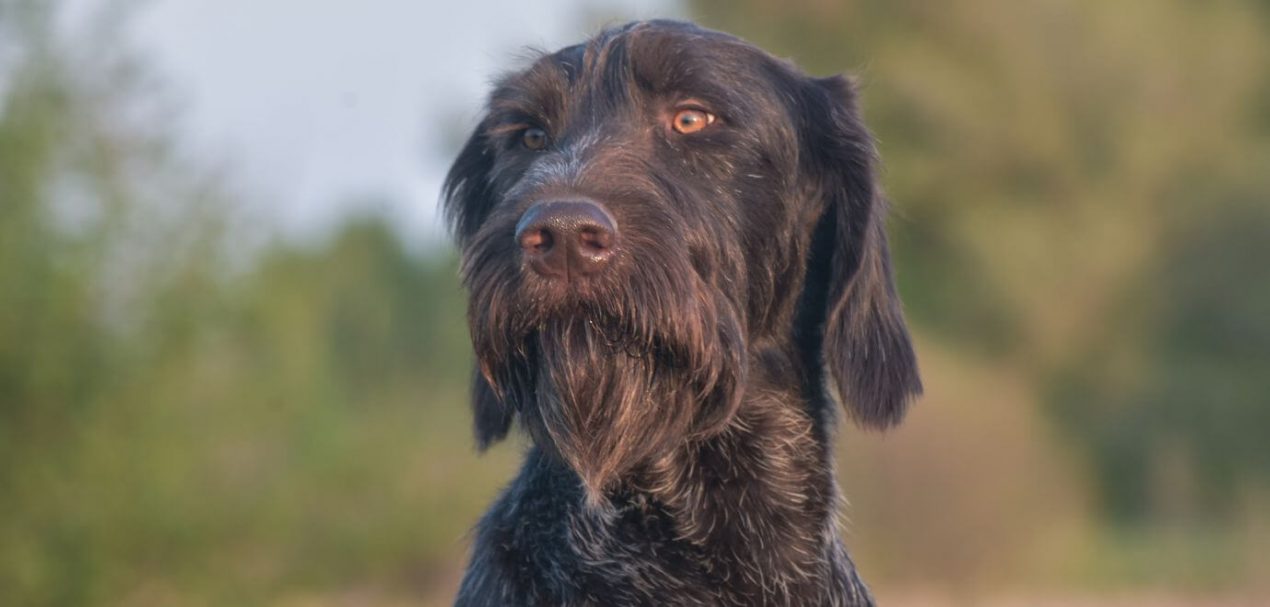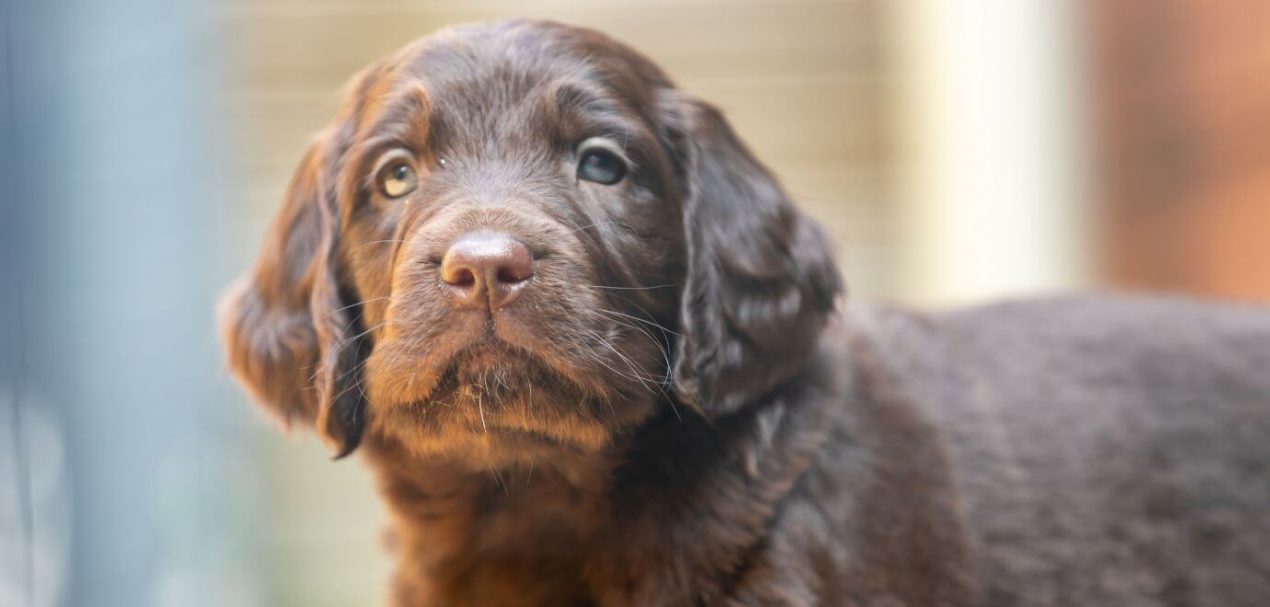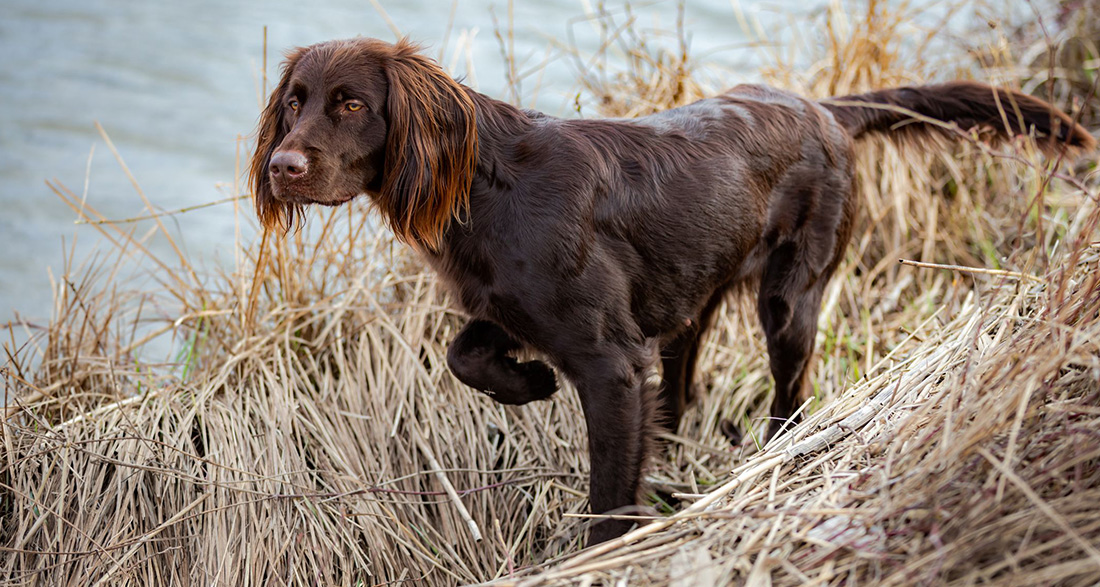The German Longhaired Pointer combines hunting skill and family-friendliness in a breed of dog that blends elegance with versatility. This article provides deep insights into everything you need to know about this impressive breed – from its historical significance to the specific requirements in grooming and nutrition, to effective training strategies. Learn how to raise your German Longhair to be a healthy, obedient, and happy family member, supported by our well-founded advice and tried-and-tested tips.
- History of the German Longhaired Pointer
- Appearance of the German Longhaired Pointer
- Character and Temperament
- Acquisition of a German Longhaired Pointer
- Development and training of the puppy
- How to Keep a German Longhaired Pointer?
- Activities with the German Longhaired Pointer
- Care for a German Longhaired Pointer
- Health and Hereditary Diseases
History of the German Longhaired Pointer
The history of the German Longhair, a pointing dog breed closely associated with hunting, dates back to the Middle Ages. The ancestors of this breed can be seen in hunting paintings from that time. In the 20th century, the German Longhair evolved into a distinct breed and officially received recognition by the Fédération Cynologique Internationale (FCI) in 1954. The breeding of this breed places particular emphasis on pure breeding and strives for high standards in the performance of the dogs. These are evaluated, among other things, in the annual Schorlemer autumn breeding test, which assesses the quality and hunting abilities of the German Longhairs.
Breed Overview
GROUP: Sporting
HEIGHT: 23-28 inches
WEIGHT: 60-71 lbs
COAT: Double coat, medium length, straight to wavy
COAT COLOR: Brown and white
LIFE SPAN: 12-14 years
TEMPERAMENT: Friendly, affectionate, social
HYPOALLERGENIC: No
ORIGIN: Germany
Appearance of the German Longhaired Pointer
The German Longhair is a medium to large-sized hunting dog with a robust, muscular build. The body structure of the German Longhair is characterized by the following features:
- Head shape: The head of the German Longhair is broad with high-set cheekbones and a wide muzzle.
- Coat: The coat of the German Longhair is long and has a silky texture.
- Coloring: The color of the coat can vary from brown to brown and white, dark roan, or light roan.
- Ears: The ears of the German Longhair are set wide apart and are medium-sized.
- Eyes: The eyes of the German Longhair are large and oval.
The German Longhair is a hunting dog, and its appearance is tailored to its hunting abilities. The robust body structure enables it to have high endurance and speed, while the head shape and ears provide it with good orientation during the hunt. The silky coat protects it from various weather conditions and gives it an aesthetically pleasing appearance.
Character and Temperament
The German Longhair is an exceptional dog with a unique character and temperament.
Here are some key characteristics that distinguish it:
- Hunting Instinct: The German Longhaired Pointer has a strong hunting instinct deeply rooted in its nature. This innate trait makes it an excellent hunting dog.
- Endurance: With its impressive endurance, the German Longhair is well-suited for strenuous hunting activities. It can cover long distances and maintain its performance even under challenging conditions.
- Friendly: This breed is known for its friendly and outgoing nature. The German Longhair is naturally affectionate and shows great affection towards its people.
- Family-oriented: The German Longhair is not only an excellent hunting dog but also an outstanding family dog. It is fond of children and patient, integrating well into family life.
With its strong character and versatile nature, the German Longhair is a true companion and partner for hunters and families alike.
| Affection Level | High |
| Friendliness | High |
| Kid-Friendly | High |
| Pet-Friendly | High |
| Exercise Needs | High |
| Playfulness | High |
| Energy Level | High |
| Trainability | High |
| Intelligence | High |
| Tendency to Bark | Medium |
| Amount of Shedding | Medium |

Acquisition of a German Longhaired Pointer
If you decide to acquire a German Longhaired Pointer as your hunting dog, there are some important things to consider. As a dog owner, you have the responsibility to be aware of the specific needs of this breed.
Here are some steps you can follow to get your German Longhair:
- Contact recognized breeding associations: To find a healthy and well-bred puppy, you should contact recognized breeding associations such as the AKC. There, you can inquire about reputable breeders and ask for a puppy that meets your requirements.
- Pay attention to hunting training: The German Longhair is a hunting dog, so proper hunting training is particularly important. Find out if the breeder has fulfilled their obligation to such training and if the puppy has already taken initial steps in hunting training.
- Visit the breeder: Before you make a final decision on a puppy, you should visit the breeder in person. This way, you can ensure that the dogs are growing up in good conditions and that you can establish a personal connection with your future companion.
- Prepare your home: Before bringing your German Longhair puppy home, make sure your home is dog-safe and that you have prepared everything necessary for its arrival, such as a cozy sleeping area, food and water bowls, and toys.
Acquiring a German Longhaired Pointer requires time, commitment, and responsibility. By following these tips, nothing stands in the way of a happy and successful partnership with your hunting dog.
Development and training of the puppy
The development and training of a German Longhair puppy is a challenging task that requires knowledge, patience, and consistency. The German Longhair is a medium-sized hunting dog with excellent all-around qualities for hunting. The breed has a long ancestral history and is considered one of the descendants of the oldest hunting dogs, the bracken, as well as the quail and hawk dogs, which were crossed with the French Epagneul (Spaniel).
Education and development of a German Longhair puppy:
- Socialization and training: From an early age, it is important to provide the puppy with good socialization to familiarize it with various people, animals, and environments.
- Consistent, yet loving leadership: A clear hierarchy is particularly important for this breed. The puppy should learn from the beginning that its caregivers are in charge and that it can trust them.
- Hunting training: As a hunting dog, the German Longhair needs plenty of exercise, movement, and meaningful activities, ideally in a hunting context.
- Professional guidance: The intelligent breed is very eager to learn and is considered easy to lead, but it requires expert guidance. Therefore, the breed is not suitable for beginners and should preferably be kept by experienced hunters.
- Species-appropriate occupation: If the German Longhair is not led for hunting, it must be occupied with substitute activities, as under-challenge can lead to behavioral problems.
Overall, keeping a German Longhaired Pointer requires a high level of commitment and expertise, especially regarding the training and occupation of the dog. A close bond and appropriate care and occupation are crucial for the well-being and development of the breed.
The Right Training
To ensure that your puppy grows into a well-behaved and obedient dog, you should consider the following training elements:
1. Socialization:
- Introduce your puppy to various people, animals, and environments early on to promote its socialization.
- Organize regular playtimes with other friendly dogs to enable social interactions.
2. Basic Commands:
- Teach your puppy basic commands such as “Sit,” “Down,” and “Stay.” These commands lay the foundation for further training and obedience.
- Reward your puppy with treats and positive reinforcement when it responds correctly to the commands.
3. Continuous Training:
- Continue training consistently to ensure that your German Longhair develops its skills.
- Establish a fixed routine for training to provide structure and security to the puppy.
4. Hunting Dog Performance Test:
- As a specialized hunting dog, participating in a hunting dog performance test can be a goal for your German Longhair’s training.
- This test assesses the dog’s performance in various hunting disciplines and enhances its skills.
5. Obedience Training:
- Good obedience training is crucial to ensure that your German Longhair listens to your commands.
- Train your dog to respond to commands such as “Come” and “Leave it” to maintain control and safety.

How to Keep a German Longhaired Pointer?
Keeping a German Longhair requires time and commitment. To care for the dog optimally, you should consider the following aspects:
- Adequate Exercise: German Longhairs are active dogs and require sufficient exercise. Ensure that your dog gets enough exercise and can move regularly.
- Fenced Garden and Walks: A fenced garden allows the German Longhair to move freely. Similarly, you should take regular walks to keep the dog sufficiently occupied and provide enough exercise.
- Engagement Opportunities: To mentally and physically challenge the German Longhair, you can offer various engagement opportunities. Fetch games, dog sports such as agility or search games are good options to keep the dog busy.
- Free Roaming: Free roaming is not mandatory for the German Longhair, but it can provide an additional opportunity for movement and exploration. However, make sure that the dog is always supervised and does not pose a danger to other animals or the environment.
By considering these points when keeping a German Longhaired Pointer, you can ensure that your dog feels comfortable and can lead a happy, active life.
Activities with the German Longhaired Pointer
German Longhairs are active dogs that require plenty of exercise and outdoor activities. They are well-suited for dog sports such as agility or dummy work. As hunting dogs, they are excellent hunting partners and can be used for tracking work or retrieving prey. The German Longhair loves being outdoors and engaging in activities with its owner.
To keep the German Longhair happy and healthy, the following activities are recommended:
- Extended walks and hikes
- Dog sports such as agility or flyball
- Outdoor fetch games
- Tracking work to promote natural hunting instincts
| Activities | Benefits |
|---|---|
| Agility | Promotes the physical fitness of the German Longhair and strengthens the bond with the owner. |
| Dummy work | Helps the German Longhair to express its hunting instinct and promotes mental challenge. |
| Leash training | Supports the control of the German Longhair and allows it to learn various hunting techniques. |
It is important to tailor the activities to the individual needs of the German Longhair and to ensure a balanced mix of exercise, mental stimulation, and social interactions. This way, the German Longhair remains healthy, happy, and balanced.
Care for a German Longhaired Pointer
Caring for a German Longhair requires special attention, especially because of its long, dense coat. Proper coat care is crucial to keep the fur in optimal condition and avoid health issues. Here are some important grooming tips:
- Daily Brushing: To prevent matting and accumulation of dirt, brush your German Longhair’s coat daily. This also helps to keep the coat shiny and healthy.
- Regular Bathing: Bathe your dog regularly with a mild dog shampoo. This is particularly important for long-haired breeds to remove dirt and odors. Make sure to choose a shampoo suitable for long-haired types.
- Parasite Check: Regularly check your dog’s coat for ticks, fleas, and other parasites. Regular use of parasite preventatives is recommended.
Ear, Teeth, and Claw Care: In addition to coat care, regular checks and cleanings of the ears, dental care, and trimming of the claws are essential parts of overall care. - Avoiding Over-Bathing: Bathing too frequently can strip the skin’s natural oils and lead to skin issues. Find a balance that keeps the coat clean without drying out the skin.
- Training and Mental Stimulation: The German Longhair is known for its intelligence and ability to learn. Regular training and mental challenges are important to keep it mentally and physically stimulated.
- Seasonal Adaptation: Adjust the grooming routine according to the different seasons. In winter, more coat care may be necessary to avoid dry skin, while in summer, more frequent parasite checks may be required.
How to Feed a German Longhaired Pointer
The diet of your German Longhair should be balanced and tailored to the individual needs of the dog. Here are some essential points to consider:
- High-Quality Dog Food: Choose a high-quality food that contains all essential nutrients and is tailored to the needs of hunting dogs.
- Balanced Nutrition: Ensure that the food provides a balanced ratio of proteins, fats, carbohydrates, vitamins, and minerals.
- Avoiding Obesity: Monitor your dog’s weight regularly and adjust the amount of food accordingly to avoid obesity.
- Access to Fresh Water: Make sure your dog has access to fresh, clean water at all times.
- Adaptation to Life Stage and Activity: Adjust the diet according to the age, health status, and activity level of your dog.
- Regular Meals: Feed your dog at regular times to establish a routine and avoid digestive issues.
- Avoiding Table Scraps: Do not feed your dog table scraps, as many foods that are harmless to humans can be harmful to dogs.
- Control of Treats: Ensure that treats make up only a small part of the daily calorie intake and use them selectively as rewards.
- Attention to Individual Intolerances: Observe your dog for signs of food intolerances or allergies and adjust the diet accordingly.
- Consultation with a Veterinarian: If in doubt or for specific dietary needs, it is advisable to consult a veterinarian.
Health and Hereditary Diseases
The German Longhair is a robust dog breed that generally does not exhibit specific hereditary diseases. However, occasional cases of hip dysplasia may occur, which can affect the well-being of the dog.
To ensure that your German Longhair remains healthy, it is important to have regular veterinary check-ups. The veterinarian can identify and treat any potential health issues early. In addition, a balanced diet is of great importance.
Here are some tips to ensure the health of your German Longhair:
- Ensure a balanced diet that meets the dog’s nutritional needs.
- Provide regular exercise and sufficient outdoor time to avoid obesity and strengthen muscles.
- Avoid excessive strain that could lead to injuries.
- Maintain proper coat care and regularly check for parasites such as ticks.
- Adhere to recommended vaccinations and preventive examinations.
By following these tips and keeping an eye on the health of your German Longhair, you can ensure that your dog leads a happy and healthy life.
Conclusion
The German Longhair is a versatile, intelligent, and affectionate companion for the whole family. Proper care, balanced nutrition, and consistent, loving training are crucial to ensure its health and well-being. Through socialization and proper training, the German Longhair develops into a reliable and obedient partner. Whether for hunting purposes or as a family pet, it is an asset to any household. By following this advice, you can be sure that your German Longhair will lead a happy and fulfilling life.


